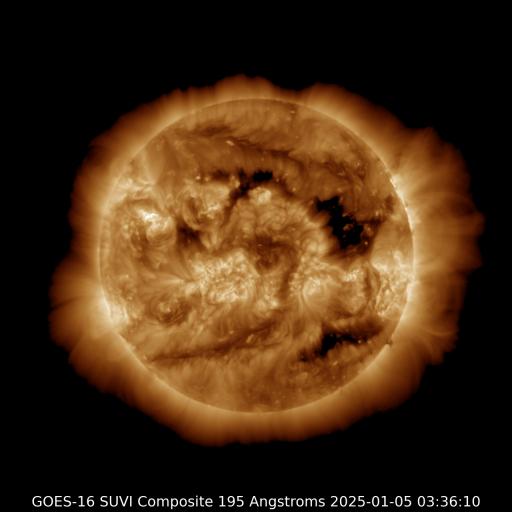Viewing archive of Sunday, 26 April 2020
Daily bulletin on solar and geomagnetic activity from the SIDC
Issued: 2020 Apr 26 1235 UTC
SIDC Forecast
Solar flares
Quiet conditions (<50% probability of C-class flares)
Geomagnetism
Quiet (A<20 and K<4)
Solar protons
Quiet
| 10cm flux | Ap | |
|---|---|---|
| 26 Apr 2020 | 071 | 010 |
| 27 Apr 2020 | 071 | 011 |
| 28 Apr 2020 | 071 | 008 |
Bulletin
Solar X-ray flux remained below B level. The developing region mentioned already yesterday, now became numbered as NOAA 2760 and developed into a small bipolar region. Solar flaring is overall expected to remain below C level over the next days.
There were no Earth directed Coronal Mass Ejections (CMEs) observed in the available coronagraphic imagery.
The greater than 10 MeV proton flux was at nominal levels over the past 24 hours and is expected to stay at nominal levels. The greater than 2 MeV electron flux has remained just slightly enhanced over the past 24 hours.
Solar wind was in a close to nominal regime with Solar wind speed around 400 km/s and total magnetic field around 5nT. Bz was unremarkable and the magnetic field phi angle was stable in the negative sector. Nominal Solar wind conditions are expected over the next days.
Geomagnetic conditions were essentially quiet with some isolated unsettled episodes locally (local K Dourbes 0-3 while NOAA Kp 0-2). Quiet geomagnetic conditions are expected over the next days with isolated unsettled episodes possible.
Today's estimated international sunspot number (ISN): 014, based on 23 stations.Solar indices for 25 Apr 2020
| Wolf number Catania | /// |
| 10cm solar flux | /// |
| AK Chambon La Forêt | /// |
| AK Wingst | /// |
| Estimated Ap | /// |
| Estimated international sunspot number | 007 - Based on 32 stations |
Noticeable events summary
| Day | Begin | Max | End | Loc | Strength | OP | 10cm | Catania/NOAA | Radio burst types | |
|---|---|---|---|---|---|---|---|---|---|---|
| None | ||||||||||
Provided by the Solar Influences Data analysis Center© - SIDC - Processed by SpaceWeatherLive
All times in UTC
Current data suggests there is a slight possibility for aurora to appear at the following high latitude regions in the near future
Edmonton, AB, Gillam, MB, Saskatoon, SK, Whitehorse, YT, Yellowknife, NTAnchorage, AK, Fairbanks, AK, Juneau, AK
Latest news
Latest forum messages
Support SpaceWeatherLive.com!
A lot of people come to SpaceWeatherLive to follow the Sun's activity or if there is aurora to be seen, but with more traffic comes higher server costs. Consider a donation if you enjoy SpaceWeatherLive so we can keep the website online!

Latest alerts
06:30 UTC - Type II Radio Emission
Begin Time: 08/04/2025 05:53 UTC Estimated Velocity: 456km/sec.
05:15 UTC - Hemispheric Power Index
The OVATION model predicts the Hemispheric Power Index to reach 50GW at 06:02 UTC
00:55 UTC - Coronal hole
A southern hemisphere coronal hole is facing Earth. Enhanced solar wind could arrive in ~3 days
Monday, 7 April 2025
20:45 UTC - Geomagnetic activity
Active geomagnetic conditions (Kp4) Threshold Reached: 20:39 UTC
17:33 UTC - Hemispheric Power Index
The OVATION model predicts the Hemispheric Power Index to reach 51GW at 18:18 UTC
Space weather facts
| Last X-flare | 2025/03/28 | X1.1 |
| Last M-flare | 2025/04/05 | M1.0 |
| Last geomagnetic storm | 2025/04/06 | Kp5 (G1) |
| Spotless days | |
|---|---|
| Last spotless day | 2022/06/08 |
| Monthly mean Sunspot Number | |
|---|---|
| March 2025 | 134.2 -20.4 |
| April 2025 | 151.3 +17.1 |
| Last 30 days | 135.2 -4.5 |




